- HOME
- Sustainability
- Time and Japanese Culture Project
- Enjoying Kabuki through “Knowledge,” “Movement” and “Sound”! In the Learning from Time event, actors, a hayashi-kata (musician), and a playwright explained the charms of Kabuki from their various perspectives.
Enjoying Kabuki through “Knowledge,” “Movement” and “Sound”! In the Learning from Time event, actors, a hayashi-kata (musician), and a playwright explained the charms of Kabuki from their various perspectives.
2023.9.25
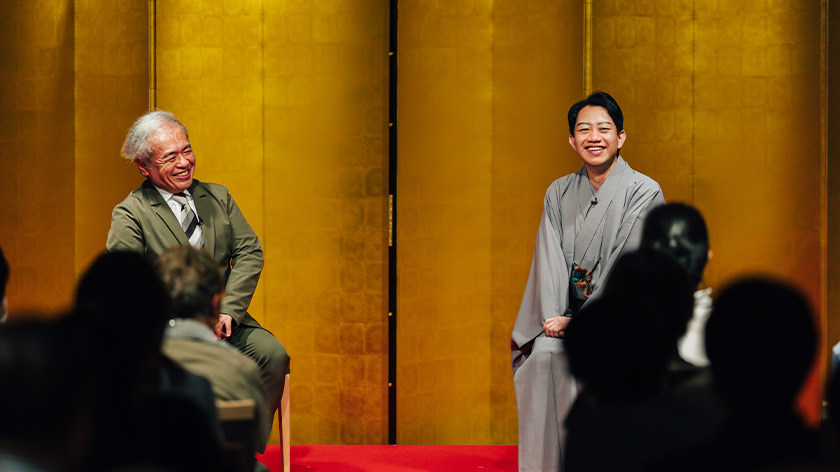
Interview and text by Sato Rika
Photographs by Ochiai Naoya
The Time and Japanese Culture Project is an endeavor to rediscover the charm of Japanese culture. As the second installment of this project, the premium event Learning from Time was held over two days at the Seiko House Ginza Hall in July 2023, providing participants an opportunity to learn about and appreciate the joys of Kabuki theatre.
The event was produced by Seiko Group ambassador and renowned Kabuki actor Danjuro Ichikawa. At the event, Kabuki actors Kudanji Ichikawa and Kazutaro Nakamura, Kabuki hayashi-kata (musician) Denjiro Tanaka, and Kabuki playwright Toyoshige Imai took the stage and explained Kabuki theatre in ways that even beginners could enjoy, focusing on aspects of Knowledge, Movement, and Sound, each according to his own special perspective.
At this event, there were 2 types of courses: “Knowledge + Sound” and “Knowledge + Movement.” The Knowledge component introduced the history and origins of Kabuki; the Sound component was entitled “Enjoying Kabuki with Your Ears;” and the Movement component demonstrated typical movements used in Kabuki. In this report, we look back on all four sessions of the event (50 people were invited to each one) and examine the lessons that each of the speakers inherited in their various roles.
table of contents
“Knowledge + Sound”: Experiencing the essence of Kabuki music through motion and the vibrations of the voice
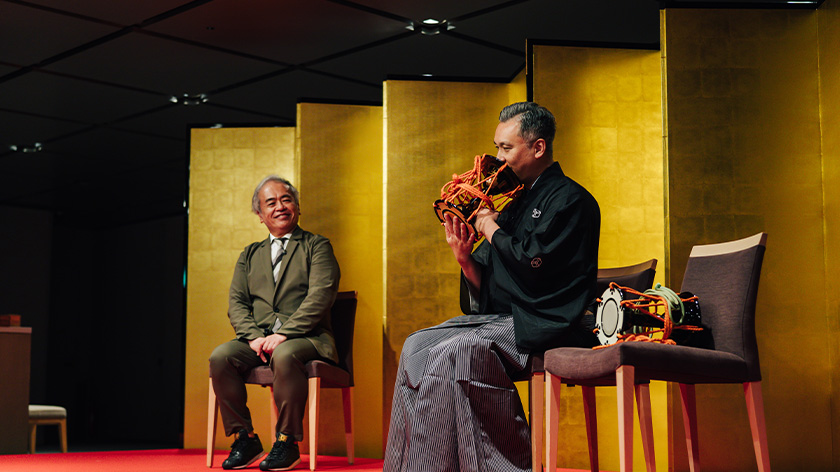
(From left) Kabuki playwright Toyoshige Imai and Kabuki hayashi-kata (musician) Denjiro Tanaka
Photographs by Ochiai Naoya
The “Knowledge + Sound” session began with the Knowledge segment, in which Kabuki playwright Toyoshige Imai explained the history and origins of Kabuki.
Kabuki originated with the Kabuki Dance of the shrine maiden and entertainer Izumo no Okuni in the early Edo period. The art has been passed down through many generations to the present day, all the while undergoing changes in key elements such as the primary performers, who were originally courtesans, then later, wakashu (young male performers), and in modern times yaro (adult male performers). The core performances changed from dance to theater, and in the process, a number of stage tricks called keren were introduced, such as the karuwaza (“lite tricks”) that include acrobatic elements, and the chunori (“riding mid-air”), in which actors fly over the audience. This is how the foundation of modern Kabuki was created over many, many years.
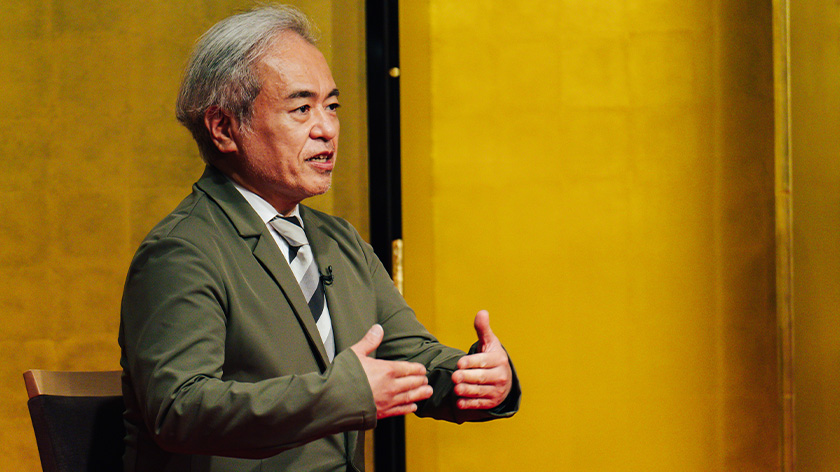
Mr. Imai is also a lecturer at universities and other institutions
Photographs by Ochiai Naoya
“Although for a time Kabuki was restricted by the Shogunate on the excuse that it was a bad influence on public morals, the art has survived the vicissitudes of time and continued to adapt. While some may see it as difficult to enjoy because of its many set practices, I hope you can see it simply as entertainment.”
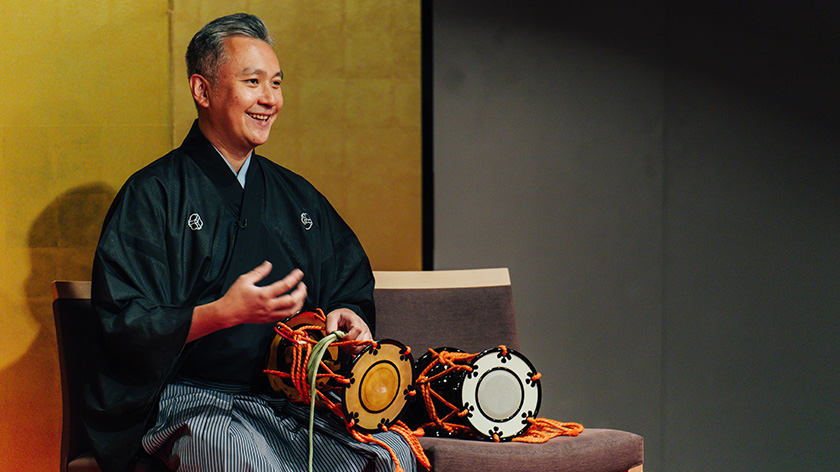
Denjiro is one of only 35 Kabuki hayashi-kata (musicians) in Japan.
Photographs by Ochiai Naoya
Next, in the “Sound” segment entitled “Enjoying Kabuki with Your Ears,” Denjiro Tanaka spoke about the roles of “musical accompaniment” and “sound effects.”
“In those Kabuki programs that are patterned on the designs of the Noh theatre stage, there is only a painting of a pine tree at the back of the stage, and the background never changes. Thus, the audience must rely on the movements and dialog of the actors, as well as the music and sound effects, to imagine a scene in their minds. The pong sound of the drum plays an important role in stimulating the imagination of the audience.”
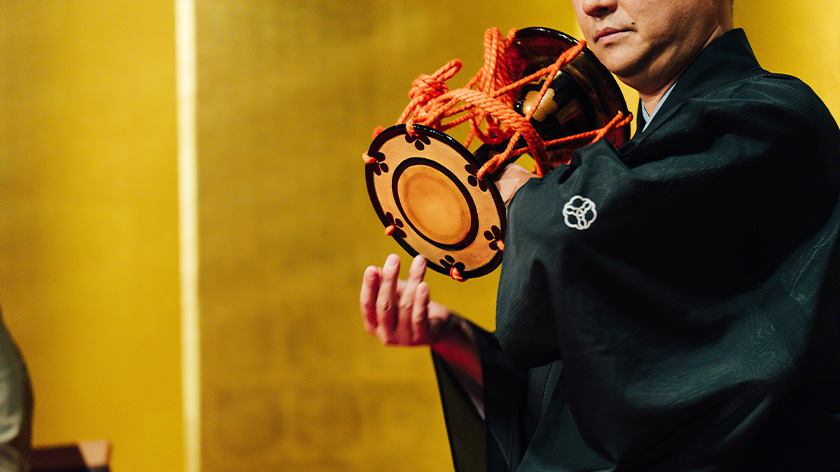
Four types of tones are used according to the scene.
Photographs by Ochiai Naoya
Picking up a drum, Denjiro explained, “The body of this drum was made in the middle of the Edo period, and the leather used is more than 150 years old.” As he struck the drum and let out a cry, the venue resounded with a beautiful, crisp sound.
Additionally, Denjiro touched on the fact that the cries of the hayashi-kata (musicians) are indispensable to expressing the unique pauses that punctuate Kabuki performances. “During my childhood, I undertook intensive training to vocalize from my belly before a musical performance,” he recalled, explaining a little-known hardship of his profession. He shared how he learned the delicate falsetto vocalizations through repeated practice while imitating his teachers.
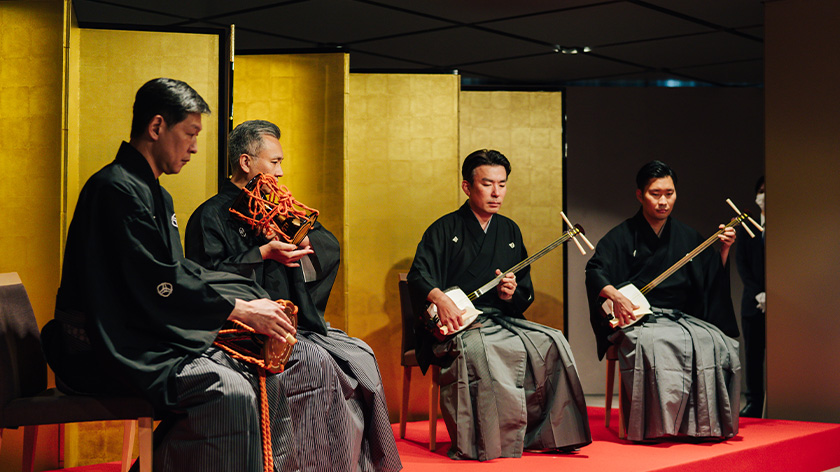
The rhythmic performance with hand drums and shamisen is like rock music.
Photographs by Ochiai Naoya
At the end of the program, there was also a demonstration of Dojoji, a masterpiece of onnagata (female role) Kabuki dance. Regarding this piece, which is characterized by the interaction between the hand drum and the shamisen, Denjiro described its charm in this way: “It’s a 4-beat piece with a bouncy rhythm that you can really feel, and it has an exhilarating quality that is similar to rock and jazz. Just the tapping of the drum evokes an image of flowers blooming at your feet.”
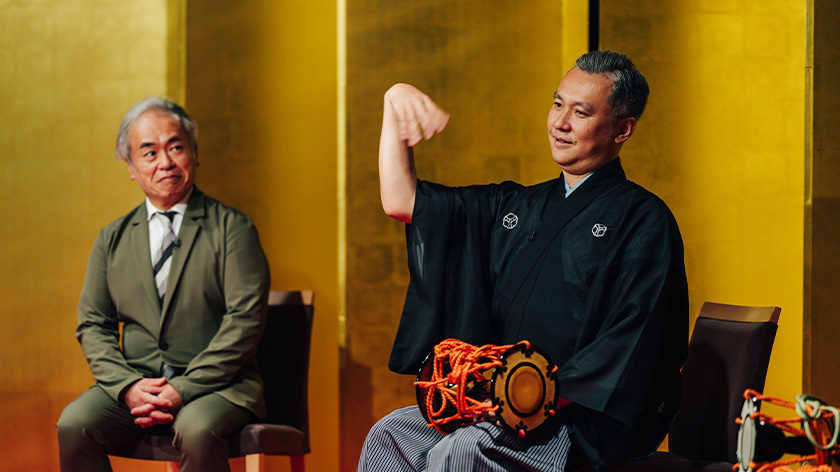
Even the flexibility of his wrist is proof of Denjiro’s training.
Photographs by Ochiai Naoya
In the “Knowledge + Sound” session, the audience heard anecdotes about “making Kabuki more interesting,” told from the perspectives of a hayashi-kata (musician) who adds depth to the drama through his performance, and a playwright who exercises creativity in the development and staging of his plays. There was also a moment in which audience members played on vinyl skin drums that are used for practice. It was a valuable opportunity to experience one aspect of traditional Japanese culture first-hand.
[Message from Toyoshige Imai]
Kabuki has a 400-year history, but I would be happy if many people could enjoy it simply as a form of entertainment, without fretting over the notion that traditional culture is hard to appreciate. Kabuki performances are often used in movies and dramas, and the more you learn about it, the more pleasure you can gain from it. I ask you to look not only at the actors, but also the stage as a whole.
[Message from Denjiro Tanaka]
The training of the hayashi-kata (musicians) is reflected in their sounds, voices, and postures. There are those who say, “The hayashi-kata must stay in the background of the stage,” but since our performances also involve great thought and care in our movements and vocalizations, all of which have a purpose, I implore you to pay attention to the hayashi-kata when you go to see Kabuki. This is a performing art that brings together advanced techniques from across the ages. Whether you are new to Kabuki or are a connoisseur, I hope you will enjoy it with both your eyes and ears.
“Knowledge + Movement”: Understanding the kumadori makeup and gestures makes Kabuki more fun
The “Knowledge + Movement” session began with a short talk by Mr. Imai, then the audience heard lectures from Kabuki actors explaining about the movements and poses while giving live demonstrations of each. During the two-day program, Kudanji Ichikawa and Kazutaro Nakamura each took the stage to give explanations and demonstrations.
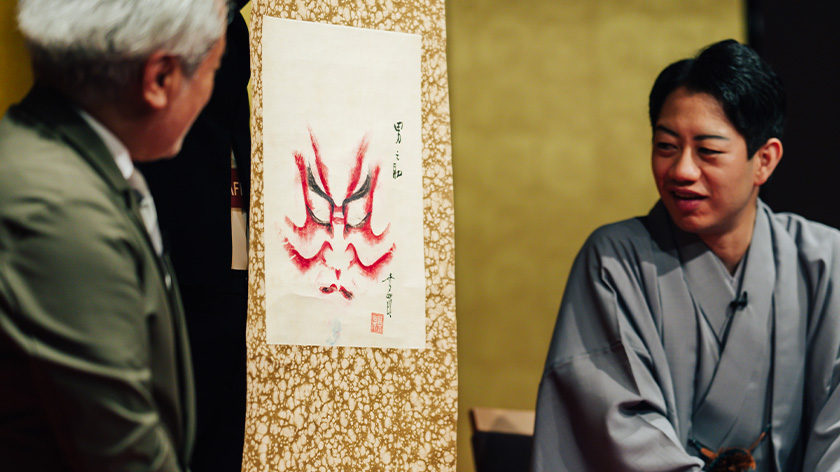
Oshiguma (impression of a Kabuki actor’s face makeup on cloth) by Koshiro Matsumoto VII
Photographs by Ochiai Naoya
The "Knowledge" segment began with an explanation of the various roles, which can be identified by the color of the makeup used on the actors’ faces. The talk was illustrated with several examples of oshiguma, which are impressions on silk or other cloth made by Kabuki actors pressing their faces to the cloth to “stamp” their character’s face via colorful kumadori makeup.
Mr. Imai explained some of the basic knowledge for appreciating Kabuki. “Red, which represents a hot-blooded temper, youthfulness, and strength, is the color used for the kumadori of ‘an ally of justice.’ Blue indicates a cold-blooded traitor, brown represents a demon or beast, and so on. So, just by observing the color of the makeup, you can understand the nature of the role.”
Kazutaro, who was listening to this explanation, interjected that “Oshiguma prints can only be made properly when you are sweating.” He lamented that “there’s not enough time in short performances to make oshiguma.”
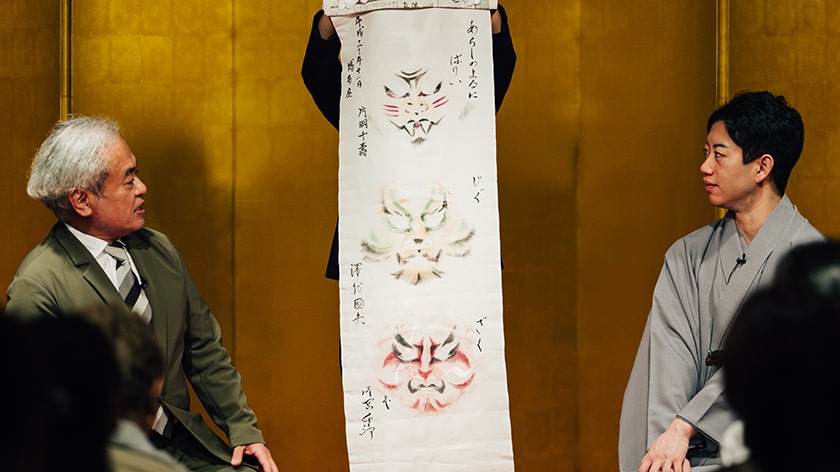
(From top) Oshiguma makeup prints of the characters Barii, Jigu, and Zaku, from the play Arashi no Yoru ni (One Stormy Night)
Photographs by Ochiai Naoya
Mr. Imai wrote the script for the play Arashi no Yoru ni (One Stormy Night), and the actors designed their own makeup for the wolves, all the while following the color conventions for kumadori.
“There is a tendency to think that anything goes in Kabuki, but it’s not true. Both playwrights and actors strive to come up with clever ways to entertain the audience while still abiding by the traditional staging conventions known as kata. Even for the popular stage trick of chunori (flying above the audience), the script must provide a reason for the main character to fly and a plan for what he does when he lands.”
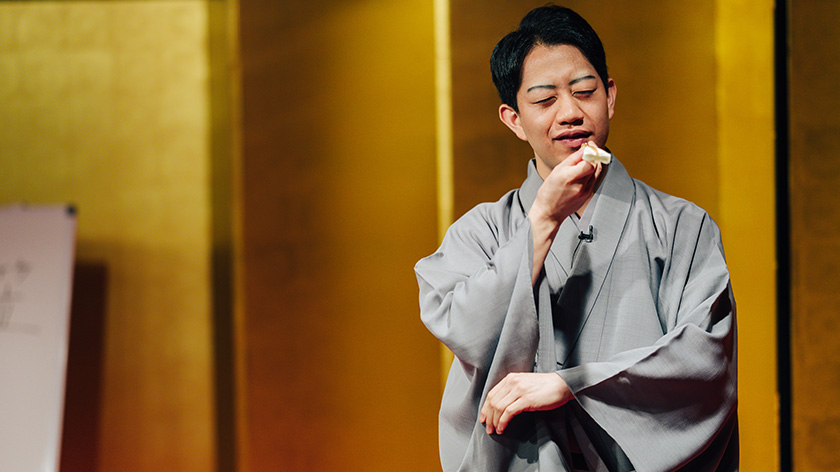
Using a folding fan to demonstrate the posture of a character enjoying a cigarette
Photographs by Ochiai Naoya
In the "Movement" segment that followed, the audience was treated to a demonstration of some of the typical Kabuki shosa (gestures and movements).
During Kudanji Ichikawa’s session, he explained some of the typical movements of Kabuki, using the roles of samurai, townsman, courier, yakko (manservant to a high-ranking person), city girl, and so on, as examples. When demonstrating the subtle differences in their mannerisms and ways of walking, he shared points on what to look for. “For minor roles such as passersby, there are often no specific instructions, so the actors who play these roles must imagine the situation and feelings of their character in order to decide how to play them. While taking care not to outshine the leading roles, they are free to come up with clever movements that are often fascinating if you know what to look for. I urge you to pay special attention to the movements of the supporting characters when watching a Kabuki play.”
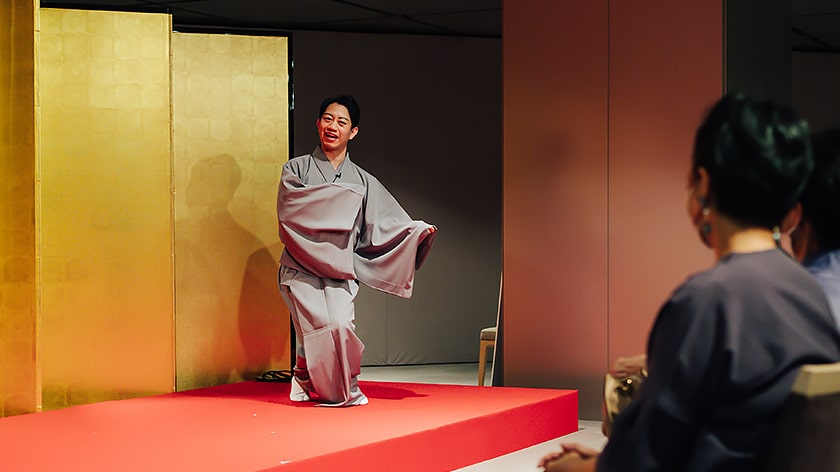
One point of a princess’s behavior is hiding her hands within her sleeves.
Photographs by Ochiai Naoya
Kazutaro Nakamura, who often plays female roles, explained how to make one’s stance look feminine on stage. “The fundamental movements of onnagata (men who play female roles) are derived from Japanese dance. The basics are to tuck your elbows in and keep your arms close to your body.” He went on to demonstrate the different movements of a princess, a common city girl, and a geisha.
“In Kabuki, the more noble the lineage of a female character, the slower her movements are likely to be. More mannish characters will walk with a swift stride, so if you pay attention to this contrast, I think it will add to your enjoyment when watching Kabuki.”
In the second half of the program, there was also a demonstration of a distinctive performance technique called mie (poses). During his session, Kudanji gave a talk about how to optimally enjoy a performance, explaining that “Kabuki is a type of theatre that involves audience participation. When an actor strikes a mie pose and is met with omukou (a shout of approval from the audience), it creates a sense of oneness between the stage and the crowd.” For omukou, the audience may call out the actor’s house or guild name.
The excitement of the event reached its peak as Kudanji struck poses and the audience responded by shouting “Takashimaya!” (the name of his guild). Kazutaro, who used a folding fan to recreate various gestures of female roles, also receive approving shouts of “Narikomaya!” (his guild) from the audience, as well as a huge round of applause.
Words alone are not enough. The true appeal of Kabuki must be experienced in the theater.
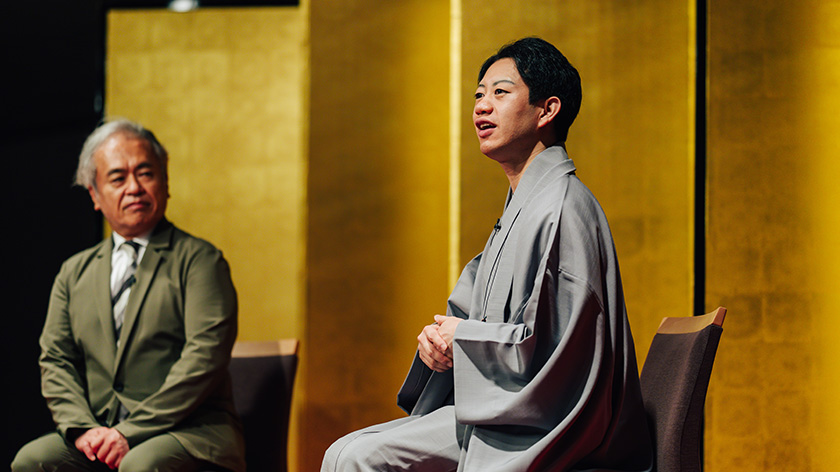
Mr. Imai and Kazutaro (Mr. Nakamura) share their thoughts on the future of Kabuki.
Photographs by Ochiai Naoya
The Knowledge + Movement session covered several points of interest on various roles, from the tachiyaku (a male lead) who strikes a pose in the center of the stage, to unnamed passersby. In the question-and-answer session at the end, a student in the audience asked poignant questions, such as, “What elements would you want to preserve above all else as fundamental to Kabuki?”
To this question, Mr. Imai responded, “The uniqueness of the live performance. Suppose you go to see a play that you know well for the first time in many years. You may get a strange feeling like, ‘Was this scene in the play?’ It is possible that the script itself has been altered, or that your reactions simply change due to different the actors and costumes. However, even if you tried to reproduce a specific Kabuki performance from any time in the past, whether a decade ago or yesterday, it wouldn’t be exactly the same as before. I believe that the essence and appeal of Kabuki is to continue to create new things while still honoring the legacy and preserving traditional forms. And, perhaps most important of all, Kabuki was, is, and always will be about entertaining the audience.”
Kazutaro nodded at Mr. Imai's words and added, “With the help of everyone involved in Kabuki, I hope we can succeed in connecting the past (tradition) to the future.” With that, the hour-long program came to a close.
[Message from Kudanji Ichikawa]
I feel that an appreciation for the space between the performer and the audience is important in entertainment, so being able to interact with the audience at this event was a very valuable opportunity.
Since Kabuki has such a long tradition, I feel compelled to practice every day. I am determined to do justice to the roles I am inheriting from those who came before me. Yet no matter how much I prepare, unexpected things will happen on the stage. This is why people who go to see the same play two or three times notice that each time there are subtle changes. I think that being able to sense these changes is one of the joys and charms of Kabuki.
[Message from Kazutaro Nakamura]
This time, I performed for the audience while dressed casually in my rehearsal clothes, which gave me an opportunity to think seriously about what kind of expression I was presenting to this audience. It was a very different feeling from performing in my full costume.
While the essence of Kabuki lies in its long history, it means nothing if what is being expressed cannot be conveyed to people today. I would like to carry on the traditions we have inherited without losing the perspective of how modern people see it. Protecting Kamigata Kabuki from the Kansai region is also part of my mission. Culture comes from many places, so diversity is very important.
In the Time and Japanese Culture Project, we will be collaborating with people who are active in a variety of fields, such as traditional Japanese craftmanship, food culture, art, entertainment, and so on. Occasionally, we will work with those people to hold events and exhibitions at Seiko House Ginza in Tokyo. Please come and experience the many attractions of Japanese culture.
Event report
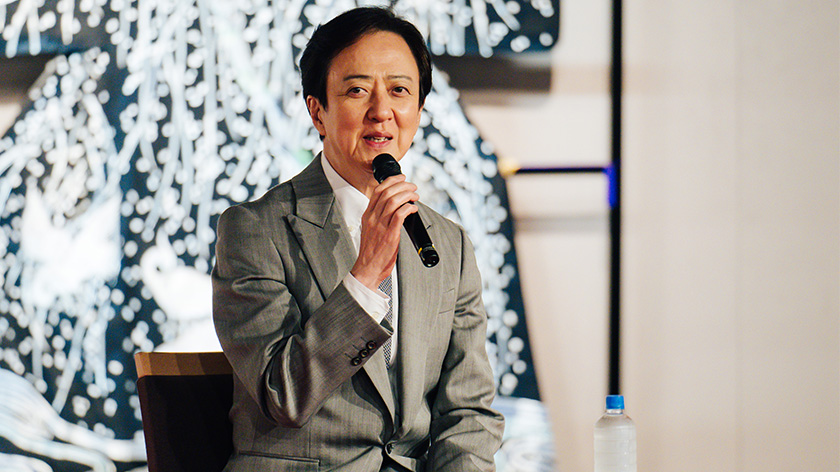
The Art of Time as woven by performers and artisans: Ten full-length costumes depicting the four seasons, presented by Tamasaburo Bando
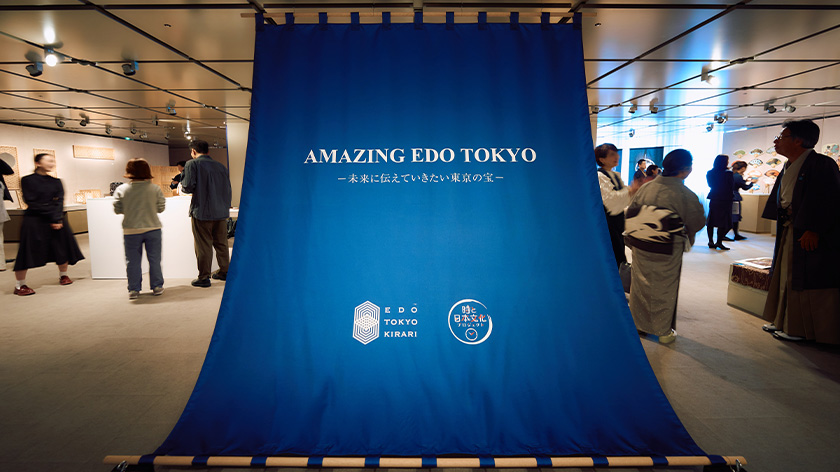
Even while it is being passed on, tradition is constantly evolving. The City of Tokyo, Wako, and Seiko have collaborated to create a special event reflecting this theme, entitled AMAZING EDO TOKYO - Treasures of Tokyo to Pass on to Future Generations.






